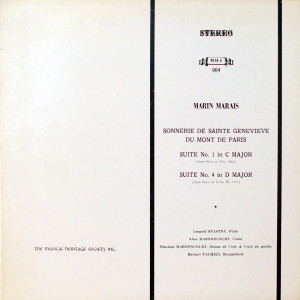 |
1 LP -
MHS 964 - (p) 1966
|
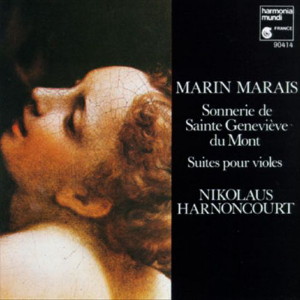 |
| 1 CD -
HMC 90414 - (p) 1987 |
|
| Marin Marais (1656-1728) |
|
|
|
|
|
|
|
| 1. Sonnerie de Sainte
Geneviève du Mont de Paris (1723) |
|
8' 43" |
A1
|
| 2. Suite No. 1 in C Major
(from Pièces en Trio, 1692) |
|
15' 28" |
A2
|
| - (Prélude - Sarabande -
Fantaisie - loure - La Bagatelle -
Gavotte - Menuet - Rondeau) |
|
|
|
| 3. Suite No. 4 in D Major
(from Pièces de Viole, Book III,
1711) |
|
24' 00" |
B1
|
| - (Prélude - Allemande -
Courante - Sarabande - La Folette -
Gigue - Gavotte |
|
|
|
- Menuets: La
Chanterelle, La Trompette
- Rondeau - Plainte - Charivary)
|
|
|
|
|
|
|
|
Alice
Harnoncourt, Violin (1)
|
|
Nikolaus
Harnoncourt, Viola da
gamba, Dessus de Viole* (1,2*,3)
|
|
Leopold
Stastny, Flute (2)
|
|
Herbert
Tachezi, Harpsichord
(1,2,3)
|
|
|
Luogo e data
di registrazione
|
| Casino Baumgarten, Vienna
(Austria) - 1966 |
|
Registrazione
live / studio
|
| studio |
Producer / Engineer
|
Dr. Kurt List / Sid Taylor,
Tape Editor (Columbia Studios)
|
Prima Edizione
CD
|
Harmonia Mundi France - HMC
90414 - (1 cd) - 48' 03" - (p) 1987
|
Prima
Edizione LP
|
Musical Heritage Society - MHS
964 - (1 lp) - 48' 03" - (p) 1966
|
| Note |
| Library of Congress Catalog
No. 70-750255 |
|
|
Notes
|
Like Vivaldi, Marin
Marais was immensly popular as a
composer and instrumentalist during his
lifetime. Over the years, however, he
has been all but forgotten. Unlike
Vivaldi, whose complete works are now
being published there is little
indication that more than a few of
Marais' works have been printed or are
being published. Considering his
historical importance and the high
quality of so much of his music, this is
regrettable.
As a virtuoso on the viola da gamba,
Marais' playing was said to be "angelic"
when compared to that of Antoine
Forqueray (a contemporary composer and
gamba player) who was said to "play like
the devil." This contrast in their
manner of performance, incidentally, is
reflected in their music. Marais' is
tender and serene while Forqueray's is
bold and full of grandeur.
Marais' compositions for viols represent
the culmination of certain aspects of
string writing which had developed over
two centuries. Although used during the
first half of the eighteenth century,
the family of viols, which had been
considered the aristocrats of string
instruments, were replaced by members of
the violin family - first in Italy, then
in England and finally in France. In
1747 Jean-Baptiste Antoine Forqueray
(son of Antoine, mentioned above, and
himself a viola da gamba player and
composer) published a volume of "Pièces
de violes." In the preface to this
volume he made a plea for the support of
royal patrons, hoping others would
emulate them and thus encourage interest
in music for the viols: "The bass-viol,
in spite of its superiorities, has
fallen into a kind of oblivion. Your
taste... can return it to the popularity
it had for so long..."
In addition to five volumes of "Pièces
de violes," Marais com posed several
operas and a "Re Deum," the latter work
written and performed on the
convalescence of the Dauphiness. Marais
was very popular with King Louis XIV,
and at one time he and his three sons
gave a concert at court, while a fourth
turned the pages of the music.
Although Marais' music is Italian in
style, it has little in common with that
of the sonata. Like Couperin's and
Rameau's, Marais' compositions usually
consist of several short movements each
of which may or may not have a
descriptive title. One of the most
famous of these compositions is the
sonata for viola da gamba and continuo.
Each movement describes some phase of a
gall-stone operation.
Couperin thought so highly of Marais'
music that in 1716 he deferred
publication of his second Book of
"Pièces de Clavecin" for one year to
allow the ebgraver to give attention to
"one of the illustrious persons of our
day who has just presented once more a
book for the viol."
According to Clyde Henderson Thompson,
whose well-written and most interesting
dissertation on Marais furnished some of
the material for these notes. "Marais'
five collections of compositions for
bass-viols loom, without question, as
the most important body of literature
for that instrument. The six hundred-odd
pieces contained in these publications
embrace the entire gamut of instrumental
expression peculiar to that
instrument... Marais' is artfully
wrought music, the creation of a
musician who was not only superbly
gifted, but imbued, as well, with a
sense of artistic integrity."
Several years ago Curt Sachs summed up
Marais' contribution to French music
when he wrote that the music for viols
"forms one of the most important
documents in the history of French
instrumental music."
Marais was also very highly thought of
by his contemporaries, and some of them
dedicated compositions to him. One
contemporary described him as "an
excellent player on the viola da gamba,
whose works are known by the whole of
Europe."
Marais' earliest biographer, Titon du
Tillet (died 1762) wrote that his music
showed polish and imagination and that
his playing had attained the "highest
degree of perfection."
The Suite No. 1 in C for Viola
da gamba, flute and harpsichord, was
published in 1692 as part of a
collection of "Pièces en Trio pour les
Flutes, Violon et les Dessus de Viole."
The volume is regarded as the first
publication of trio sonatas to appear in
France. Although Marais specified flutes
in the title, according to the practice
of the time, these pieces might be
played by almost any two treble
instruments and a harpsichord. The
"Pièces en Trio" were dedicated to a
Madame Roland who had the repitation of
an adventuress as well as an
accomplished ballerina. The dedication
reads in part:
"No one is unaware of the qualities
that you posses; every one knows what
refinement you have for music, what
facility for singing well, and for
playing well on all
instruments... it is not known
that it was you who have contributed
most to whatever good may be found in
the book that I have the honor to
present to you. They do not know that
the pleasure you have shown in hearing
most of these pieces that are inserted
here has been the only thing that has
made me work with diligence, in the
desire that I have always had for
rendering myself worthy of the favors
with which you honor me."
Marais, like Couperin, frequently gave
his compositions titles, also giving
titles to the individual movements.
Composed in 1723, Sonnerie de Sainte
Geneviève du Mont de Paris is not
only a description of church bells, it
also portrays scenes in the lives of the
people who listen to them, as at prayer,
going to church, etc. An interesting
feature of this work is the use of the
violin which was rapidly replacing the
treble viol as the highest of the string
instruments.
The Suite No. 4 in D is from the
third volume of "Pièces de violes" which
was published in 1711. By this time,
Marais had achieved a considerable
amount of fame and had a large public
for his music. The dedication, "Au
Public," reads in part:
"The honor which the public
has paid me in playing my pieces for
nearly thirty years has led me to
dedicate to it this third book. I hope
that the public will be so kind as to
observe that all the care I have taken
in this work has bad no other object
than to give it pleasure. The great
number of short and easily performed
pieces which make it up are proof that
I have wanted to satisfy the urgent
solicitations that have been
reiterated to me so many times, on all
sides, since my second book... the
addition of some marks that are not in
my two preceding books and which are
essential for the style of my pieces,
should persuade the public that I have
neglected nothing in order to merit
the favor with which it has honored me
up to now."
In the preface to the volume, Marais
says that although composed for viol and
continuo, the pieces may also be
performed on such diverse instruments as
the organ, harpsichord, violin, guitar,
flute, recorder, or oboe.
Douglas Towsend
(The harpsichord used is a copy of
an instrument in the Netherlands
manner built by Kurt
Wittmayer, Gartenberg near
Wolfratshausen, Bavaria, Germany)
|
|
Other Editions
|
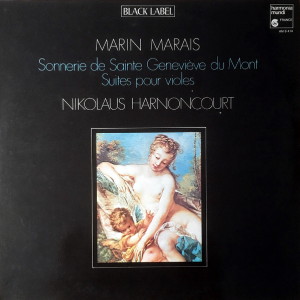 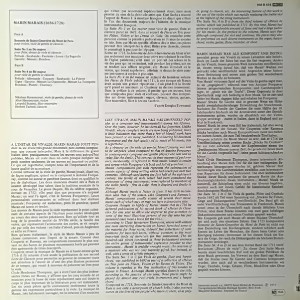 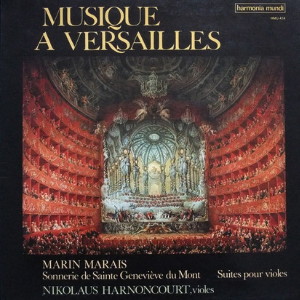  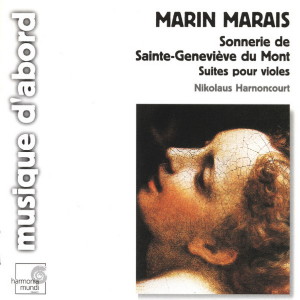 |
- Harmonia
Mundi "Black Label" - HMB 414 - 1 LP - (p)
1973
- Harmonia Mundi - HMU 414 - 1 LP - (p)
1976
- Harmonia Mundi "Musique d'abord" - HMA
195414 - 1 CD - (p) 2004
|
|
|
|
Nikolaus
Harnoncourt (1929-2016)
|

|

|
|